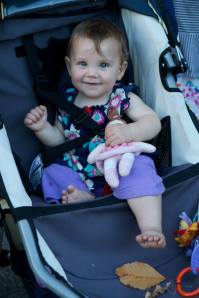
I’m a huge baby-wearing fan. My first daughter literally fell asleep in the carrier, and only in the carrier, for the first 21 months of her life. She lived in a brown Boba for almost two years. She did weddings, funerals, holidays, shopping, walking, cooking with me. I couldn’t imagine doing it any other way. I loved wearing her, and assumed the rest of my babies would have that same luxury of living their first few years so close to mama.
Shortly after my second daughter was born though, I realized it wasn’t going to be such smooth sailing. I had incredibly painful varicose veins for much of my second pregnancy, and though they went away after birth, once my baby passed the ten pound mark, I could feel them flaring slightly. As her weight increased, my leg felt worse, and around six months postpartum, I developed pelvic pain and hemorrhoids that made it challenging to hold her, never mind wear her.
I felt guilty, sad, and at a loss. It seemed like one of my best mothering tools had been taken from me. Luckily, my daughter was an early crawler, and a very content baby so I managed to make dinners and do other tasks around the house while she played, instead of carrying her. But still, I wanted to be close to her. I’ve had to be more intentional but I’ve worked through the feelings of loss and instead try to focus on the ways we CAN bond! Here are my top five ways of staying connected to my daughter while trying to preserve my body.
1. Co-sleeping. My little one sleeps in the crook of my arm part of the night, sometimes on my chest, and sometimes, when I’m tired, on the other side of the bed. But we are always close, and I wouldn’t trade our nighttime snuggles for anything – not even an uninterrupted night’s sleep! We also spend about a half hour snuggling in the morning with her older sister in the bed, so everyone feels like they have their physical needs for love and affection met before our feet hit the ground! (If you’re concerned about safety, check out some of Dr. James McKenna’s research on safe co-sleeping, and his safety guidelines.)
2. Co-bathing. Yup, it’s as easy as it sounds. Jump into the bath with your baby. If they are going through that distracted nursing stage, it’s a great way to gently encourage a good feed. It’s relaxing for you too!
3. Floor time! I am so much more intentional about tumbling on the floor with my second baby. She does “airplane” on my legs while I lie on my back, and crawls over, under, and around me. I barely ever sit on a couch, and when I do crafts or read with my older daughter, we always sit on the floor instead of at the table, so the baby can participate at all times. We also do lots of hugs and kisses on the floor.
4. Use your stroller wisely. I didn’t use a stroller at all until my eldest turned 2. And even then I used it sparingly. I just felt like they inhibited our freedom to walk off the path, to get through doors, down stairs etc. I still feel that way, but there’s no way we could do museums or park trips without one now that I can’t hold my baby for more than a few minutes at a time. I try to push her to a destination, and then take her right out, and play on the floor for a bit before we need to move again.
I considered buying a stroller with a seat that faced toward me, but I knew my girl wouldn’t be in a stroller for that much longer–as soon as my kiddos can walk, they do–it just takes a bit longer to get places! If circumstances were different though, I may have bought something like this as a long term investment so I could interact and so that my girl could feel safe. (When babies face the world in their stroller, it can be stressful.) As it is, I like to have my older daughter push the stroller when we walk around town, and I sometimes walk next to or in front of the stroller, making faces, and being silly with the baby.
5. Relax. We are an on-the-go family. We live close to downtown Boston, and my older daughter and I used to go into town weekly. We loved riding the train, exploring the parks in the city, and going to museums. It’s been really hard for me to slow down in that respect, and plan our day around home naps (rather than carrier naps, as in the past), but it’s been a sweet time for my older daughter and I to have time cooking, drawing, reading, or just resting. It’s a season! Before I know it, my baby will be walking, and it will be hard to catch her, never mind pick her up!
**
A few other strategies made life a bit easier too. Accept help! Dad puts baby to bed when he’s home, Nana carries her down the stairs if we are going out together, Big Sister watches her when I run to the laundry. At church, instead of carrying the baby up the stairs to Sunday School while I drop off her sister, I leave the baby downstairs with a loving friend. (One of her favorites happens to be a male friend who is at least 6’4″ with glasses and a booming voice. He’s also a trained NICU nurse.)
I’m also much more organized. All the diapering supplies are in one place. The things we need to get out the door are all by the door. I can’t afford to be running around the house looking for things with her in my arms. I also do use the Ergo back carry in a pinch!
**************************************************************************
 Megan McGrory Massaro is a mother, freelance writer, and author. She wrote The Other Baby Book: A Natural Approach to Baby’s First Year to empower women to make the best choices for their families.
Megan McGrory Massaro is a mother, freelance writer, and author. She wrote The Other Baby Book: A Natural Approach to Baby’s First Year to empower women to make the best choices for their families.








